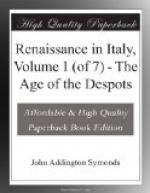CHAPTER II.
ITALIAN HISTORY.
The special Difficulties of this Subject—Apparent Confusion—Want of leading Motive—The Papacy—The Empire—The Republics—The Despots—The People—The Dismemberment of Italy—Two main Topics—The Rise of the Communes—Gothic Kingdom—Lombards—Franks—Germans—The Bishops—The Consuls—The Podestas—Civil Wars—Despots—The Balance of Power—The Five Italian States—The Italians fail to achieve National Unity—The Causes of this Failure—Conditions under which it might have been achieved—A Republic—A Kingdom—A Confederation—A Tyranny—The Part played by the Papacy.
After a first glance into Italian history the student recoils as from a chaos of inscrutable confusion. To fix the moment of transition from ancient to modern civilization seems impossible. There is no formation of a new people, as in the case of Germany or France or England, to serve as starting-point. Differ as the Italian races do in their original type; Gauls, Ligurians, Etruscans, Umbrians, Latins, Iapygians, Greeks have been fused together beneath the stress of Roman rule into a nation that survives political mutations and the disasters of barbarian invasions. Goths, Lombards, and Franks blend successively with the masses of this complex population, and lose the outlines of their several personalities. The western Empire melts imperceptibly away. The Roman Church grows no less imperceptibly, and forms the Holy Roman Empire as the equivalent of its own spiritual greatness in the sphere of secular authority. These two institutions, the crowning monuments of Italian creative genius, dominate the Middle Ages, powerful as facts, but still more powerful as ideas. Yet neither of them controls the evolution of Italy in the same sense as France was controlled by the monarchical, and Germany by the federative, principle. The forces of the nation, divided and swayed from side to side by this commanding dualism, escaped both influences in so far as either Pope or Emperor strove to mold them into unity. Meanwhile the domination of Byzantine Greeks in the southern provinces, the kingdom of the Goths at Ravenna, the kingdom of the




